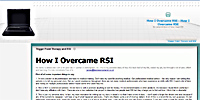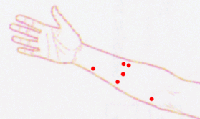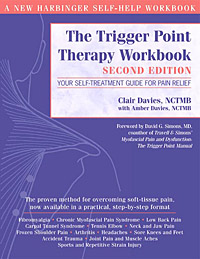 I have had more than my fair share of connective tissue injuries in my life so far. Indeed one of the reasons for getting into sea kayaking was because of cartilage damage to both of my knees. As documented in this blog I have also had serious repetitive strain injuries in both forearms from working with computers for a long time. So maybe it doesn’t come as a surprise to me that kayaking can also cause injury, since paddling is repetitive and can be a strenuous activity.
I have had more than my fair share of connective tissue injuries in my life so far. Indeed one of the reasons for getting into sea kayaking was because of cartilage damage to both of my knees. As documented in this blog I have also had serious repetitive strain injuries in both forearms from working with computers for a long time. So maybe it doesn’t come as a surprise to me that kayaking can also cause injury, since paddling is repetitive and can be a strenuous activity.
The main reason that I have been able to do kayaking is that my repetitive injuries in the arms have been localised in the forearms, wrists and hands. Kayaking is is an activity that is mainly done using the upper arms, shoulders and body for rotation and, as such, is not an activity that aggravates computer related RSI in the forearms. I do, however, have to be careful with my bad right hand wrist. I have also had to use a neutral bent crankshaft paddle to keep the wrists from flexing, which does create pain with a more straight shafted paddle.
What I have recently been experiencing is pain around the elbows, that becomes apparent when kayaking, but goes away when I stop paddling for the day. Having been acutely aware of repetitive injuries, and also having read some good resources, I have at least identified what I believe is causing my elbow pain, I just haven’t yet figured out how to stop it from occurring in the first place!
A very useful resource for sore and tight muscle tissue and referred pain is “The Trigger Point Therapy Workbook” by Claire Davies a book which I have referenced in previous posts. From doing an analysis of the pain in my outside elbow, I was able to see that a common referrer for such pain is the triceps muscle group. According to the book (ref pg 101-103, ‘Triceps’) there are trigger points in 5 separate areas of the triceps than can refer pain into the outer elbow. Probing the triceps with my thumb identified an extremely sore and tight inner triceps muscle (referred to in the book as number 1 trigger point), about 4 inches down from the armpit. There were also very tight and sore muscles at the lower end of the triceps right where it meets the elbow (referred to in the book as triceps trigger point areas 2, 4 and 5). I had no tightness in the outer triceps (called triceps trigger area 3).
The tricep/elbow pain issue has come about as a result of a few windy, ‘slog’ like paddles where I am perhaps gripping the paddle tighter than normal, whilst pushing against the wind, coupled with perhaps a non optimal paddling technique. I maybe need to work on more torso rotation on those windier days out, or perhaps switch to a more straight arm paddling style. I may also have to introduce some warm up stretches before setting off to paddle.
The triceps are one of the harder muscle groups to stretch out, and one of the only ways seems to involve putting your arm right over your head whilst pushing against your elbow or holding a weight to stretch the triceps further, which involves rotating the shoulder joint as far as possible, which isn’t ideal.
I have started some nightly massage as well as stretching of the triceps muscles and some weights exercises in the hope that I can get them to quickly settle down to a less tight state and obtain some pain free paddling as a result.



